AWS Solutions Architect Associate Certification
Services Application Integration
Elastic Loadbalancing
In this article, we explore AWS Elastic Load Balancers and why they are essential for building scalable and highly available cloud architectures.
Introduction to Load Balancers
Imagine hosting your website, mywebsite.com, on a single EC2 instance. Initially, as traffic remains low, a single instance may be sufficient. However, as your site gains popularity, a single server may struggle to handle increased load. There are two primary scaling strategies:
- Vertical Scaling: Increase the capacity (CPU, RAM) of your EC2 instance.
- Horizontal Scaling: Add more EC2 instances to distribute the traffic. However, even with multiple servers, the domain (mywebsite.com) still points to a single IP address unless a load balancer is implemented.
This is where load balancers become indispensable. They provide a unified domain name for users while distributing incoming requests across multiple EC2 instances.
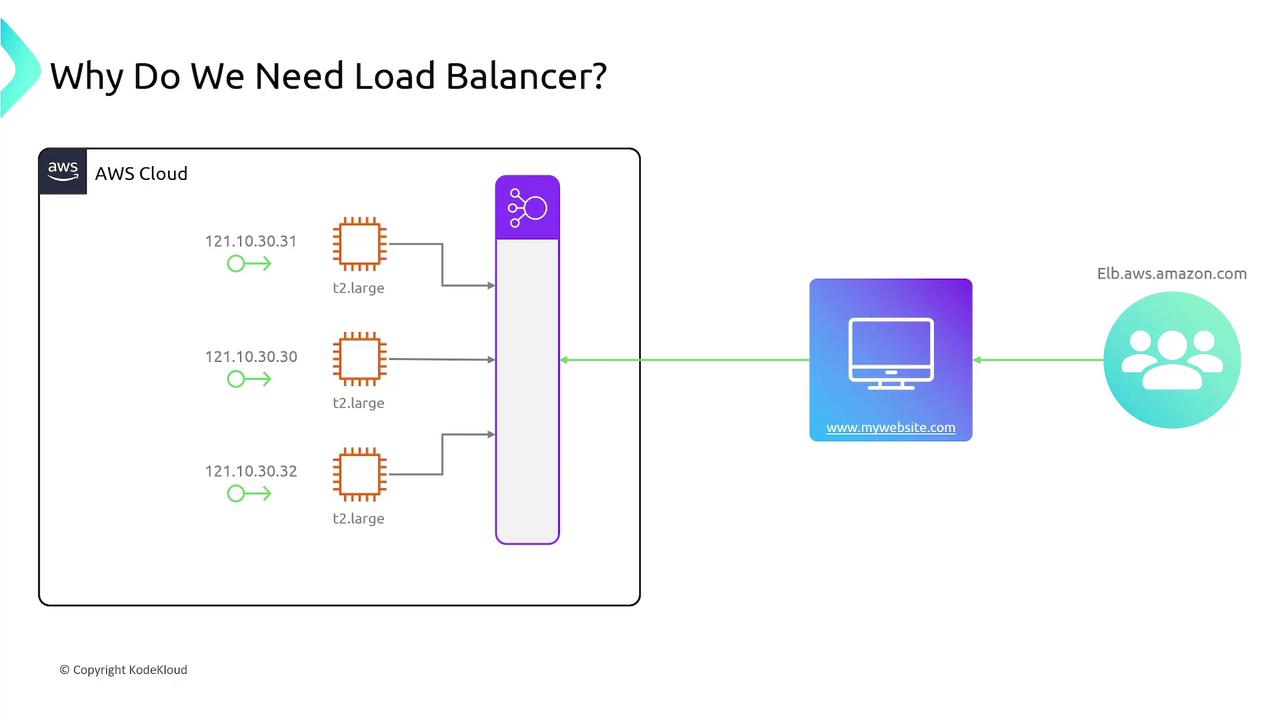
By balancing the load evenly, these devices enhance both application performance and availability.
AWS Elastic Load Balancers Overview
AWS offers a robust, scalable, and fault-tolerant load balancing service that spans multiple availability zones. Instead of restricting traffic to a single EC2 instance or availability zone, the load balancer intelligently forwards incoming requests to all configured instances across zones.
Before exploring the different types of load balancers, let's review two critical components of their configuration: Listeners and Target Groups.
Listeners and Target Groups
Listener: A listener defines the rules for processing incoming traffic. For instance, you might configure a listener to accept HTTP requests for
http://www.mywebsite.com.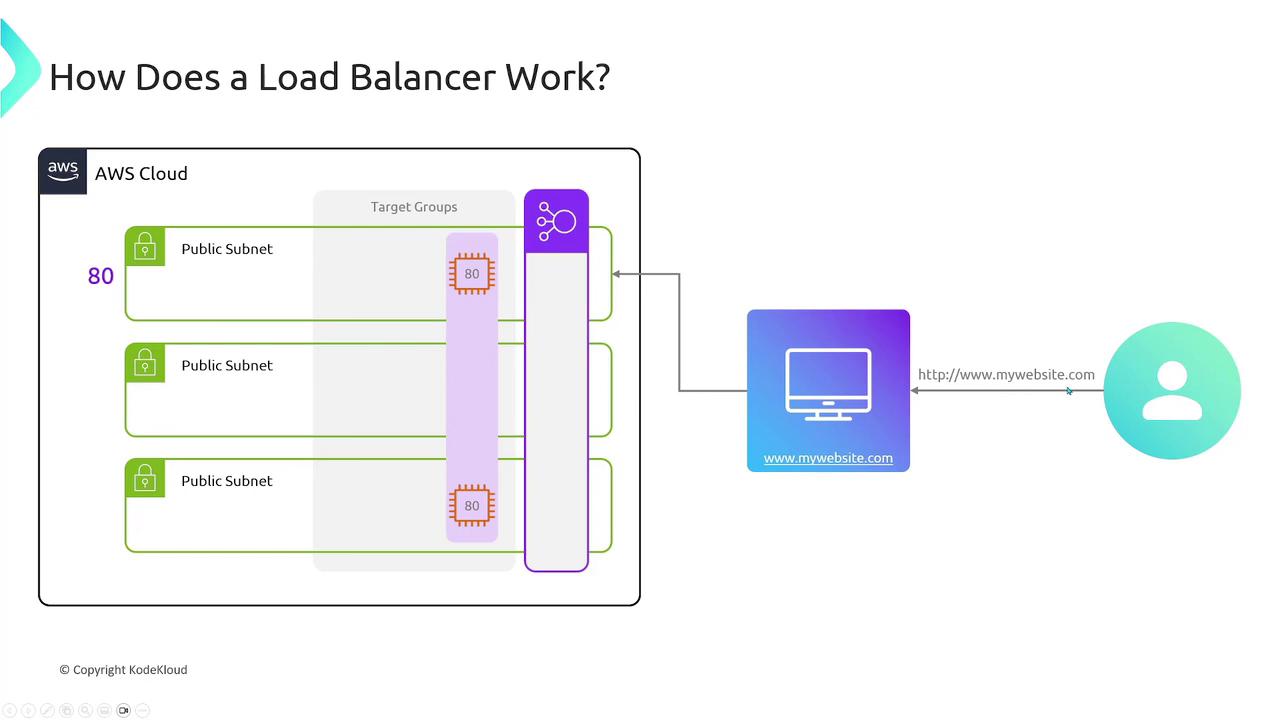
Target Group: A target group is a collection of endpoints, such as EC2 instances, that receive the forwarded requests. You can specify the port on which these endpoints listen (e.g., port 80 for HTTP or port 443 for HTTPS).
For example, to enable HTTPS traffic on port 443, you can configure a listener for port 443 and route requests to a target group operating on that port. Similarly, additional listeners (e.g., on port 8080) can support different types of requests.
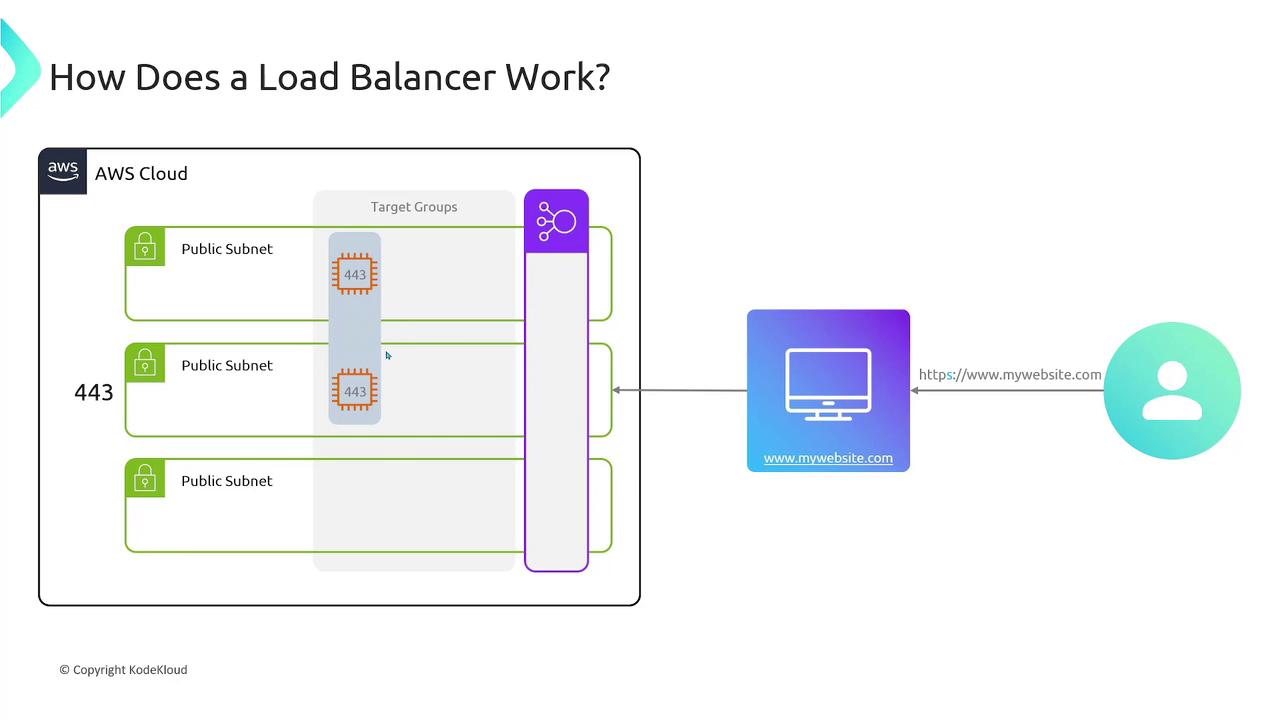
This setup allows a single entry point to distribute incoming requests to the appropriate group of servers. Additionally, target groups can include various endpoint types (such as EC2 instances, IP addresses, Lambda functions, or even other load balancers) and support health checks for monitoring endpoint availability.
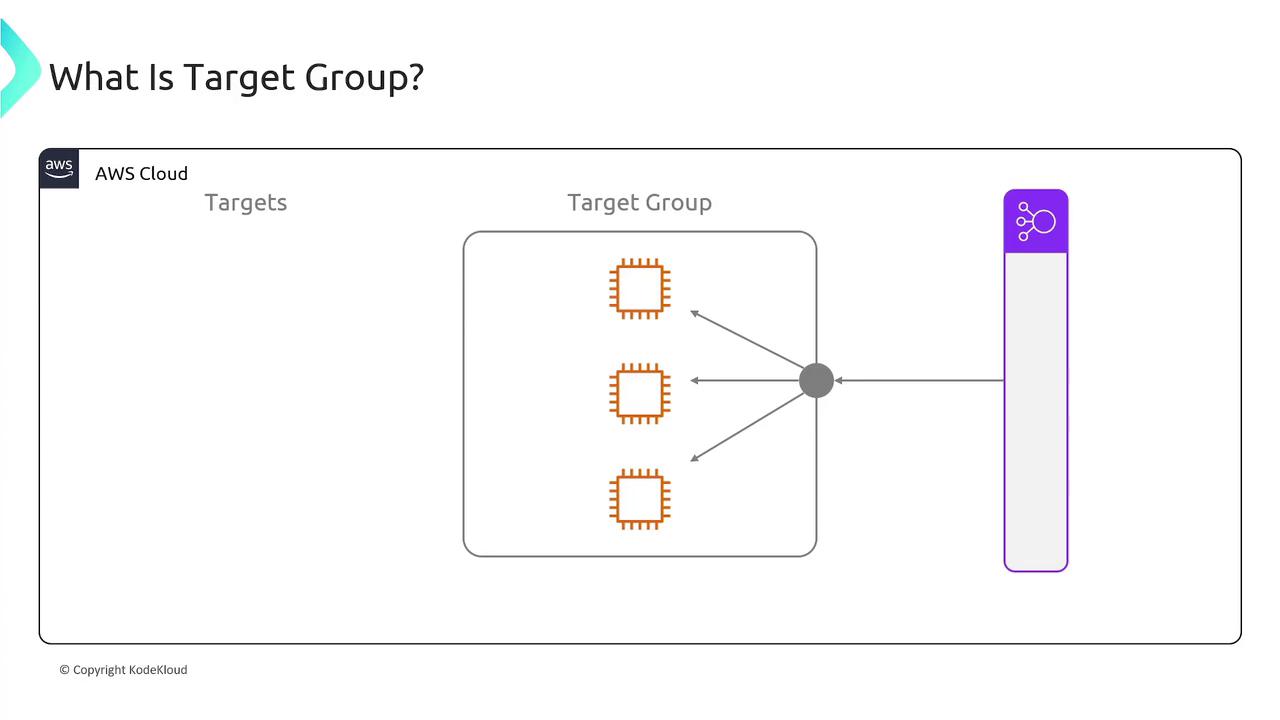
Key Characteristics of Target Groups
A target group in AWS can include:
- EC2 Instances: Multiple instances that handle traffic.
- IP Addresses: Direct traffic to specific IP addresses, whether hosted on-premises or in another cloud.
- Lambda Functions: Use serverless functions as backend endpoints.
- Other Load Balancers
Supported protocols include TCP, UDP, TLS, HTTP, HTTPS, and even gRPC. With regular health checks, the load balancer ensures that only healthy endpoints handle traffic.
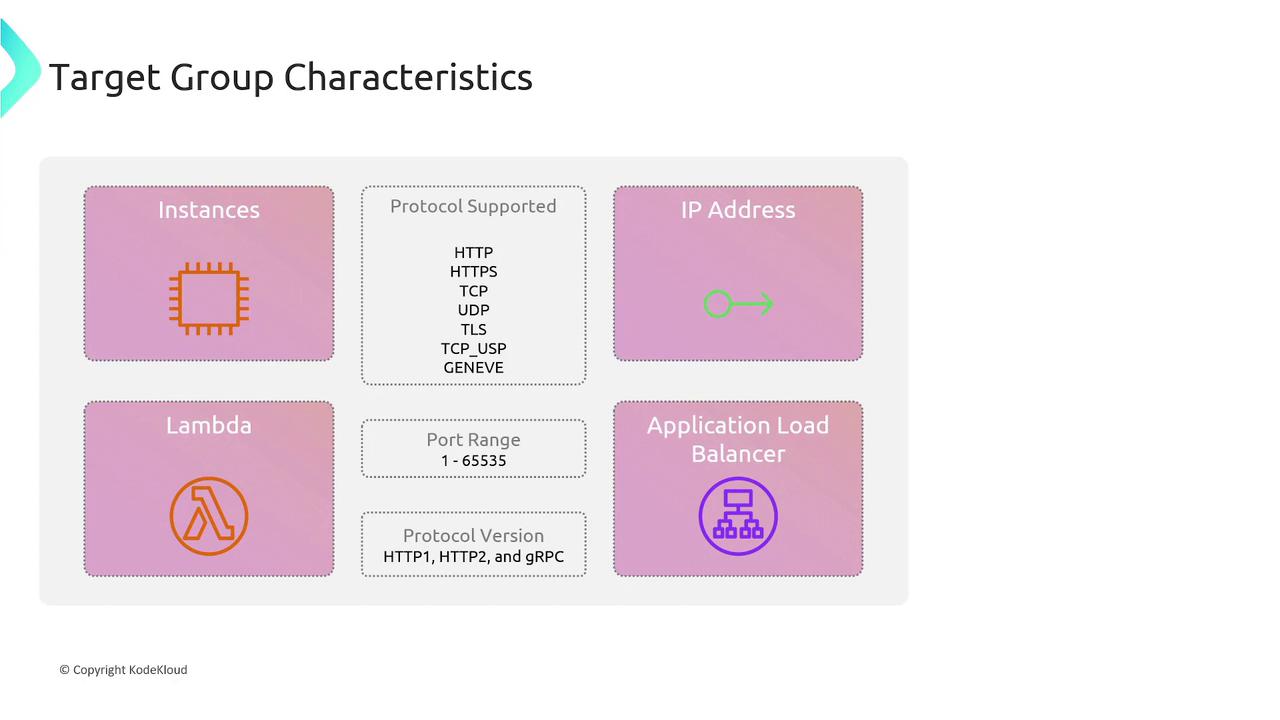
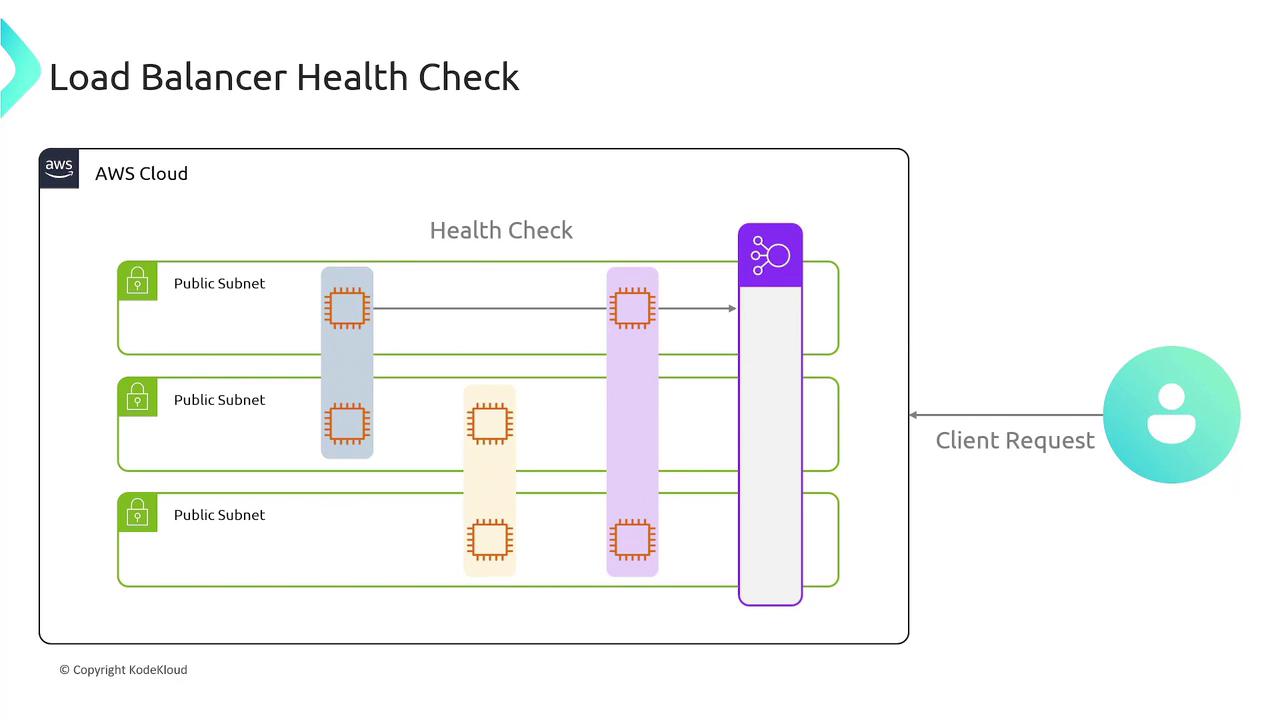
Public vs. Private Load Balancers
AWS load balancers can be deployed as either:
- Public Load Balancers: Exposed to the internet, ideal for public APIs and web applications.
- Private Load Balancers: Restricted to a private network, perfect for backend services or databases where security is a priority.
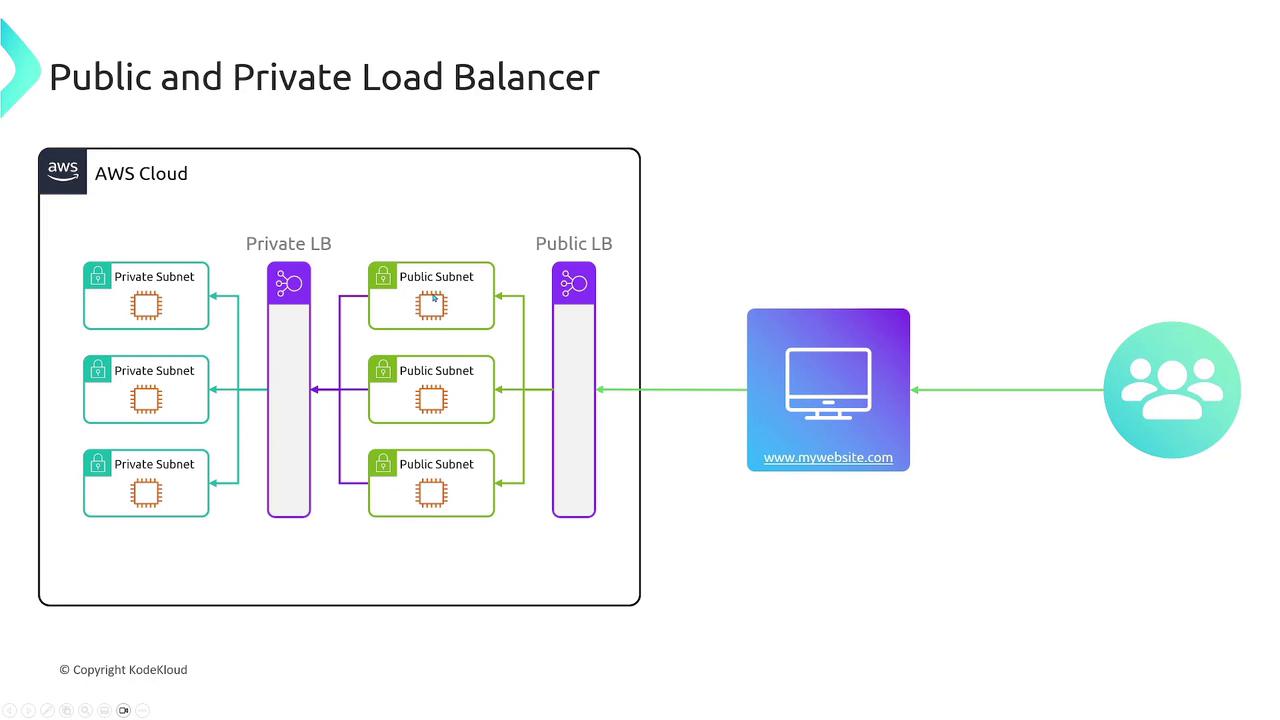
When deploying a load balancer, you select specific availability zones and subnets. With cross-zone load balancing enabled, traffic is evenly distributed across instances in different zones. Without it, each load balancer node only routes traffic within its zone, which can lead to an uneven load.
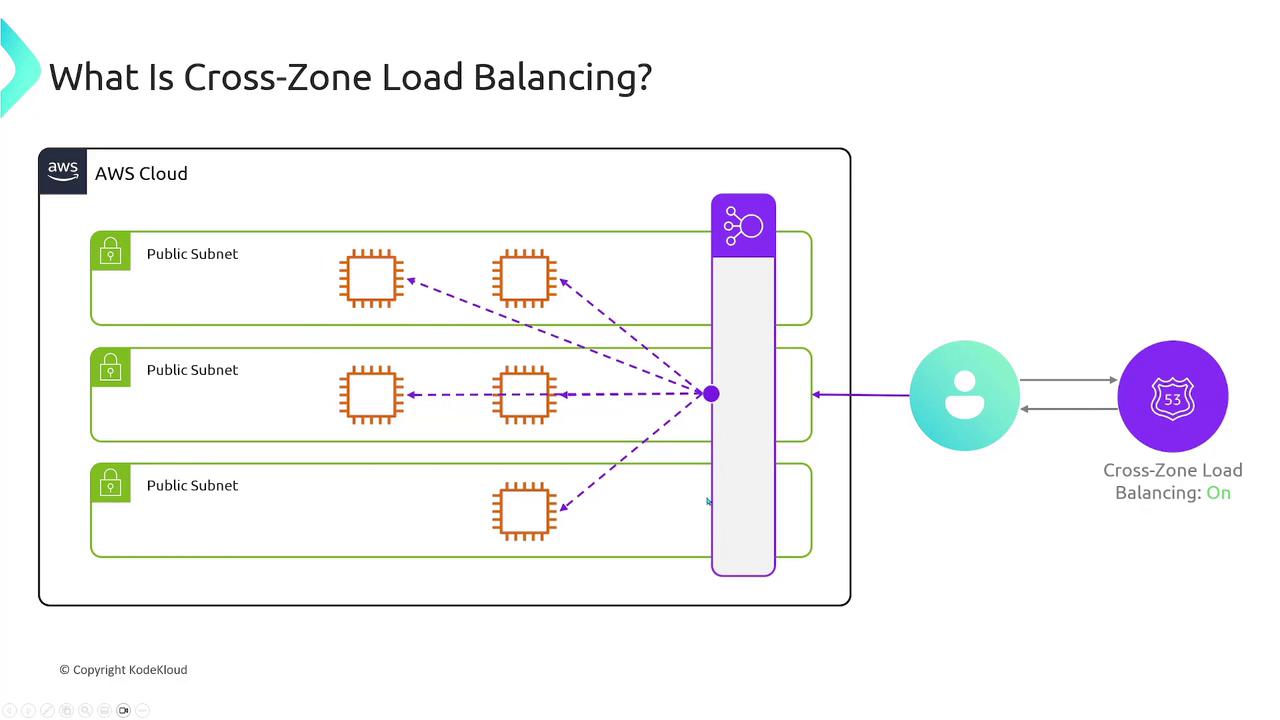
Types of AWS Load Balancers
AWS offers several types of load balancers, each designed for specific use cases:
Application Load Balancer (ALB)
- Operates at Layer 7 (the application layer) and is aware of HTTP/S traffic.
- Supports advanced routing rules based on host headers, URL paths, HTTP methods, query strings, and custom headers.
- Ideal for web applications and microservices requiring flexible routing and redirection.

Network Load Balancer (NLB)
- Operates at Layer 4 (the transport layer) and supports protocols such as TCP, UDP, and TLS.
- Designed for high-performance applications, capable of handling millions of requests per second.
- Provides static IP addresses per availability zone, offering greater routing control.
When you configure an NLB, a network interface is created in each availability zone. For internet-facing NLBs, an optional Elastic IP can be assigned for each subnet.

The NLB routes traffic based solely on port numbers. For example, traffic arriving on port 8080 can be directed to one target group, while traffic on ports 80 and 443 is sent to different groups.
Advanced ALB Features and Routing Rules
Because the Application Load Balancer operates at Layer 7, it provides advanced traffic management options:
Host Header Matching: Route traffic based on domain names.
- Default rule: Applies when no specific host is matched.
- Custom rule: For instance, route traffic for
blog.mywebsite.comto a dedicated target group.
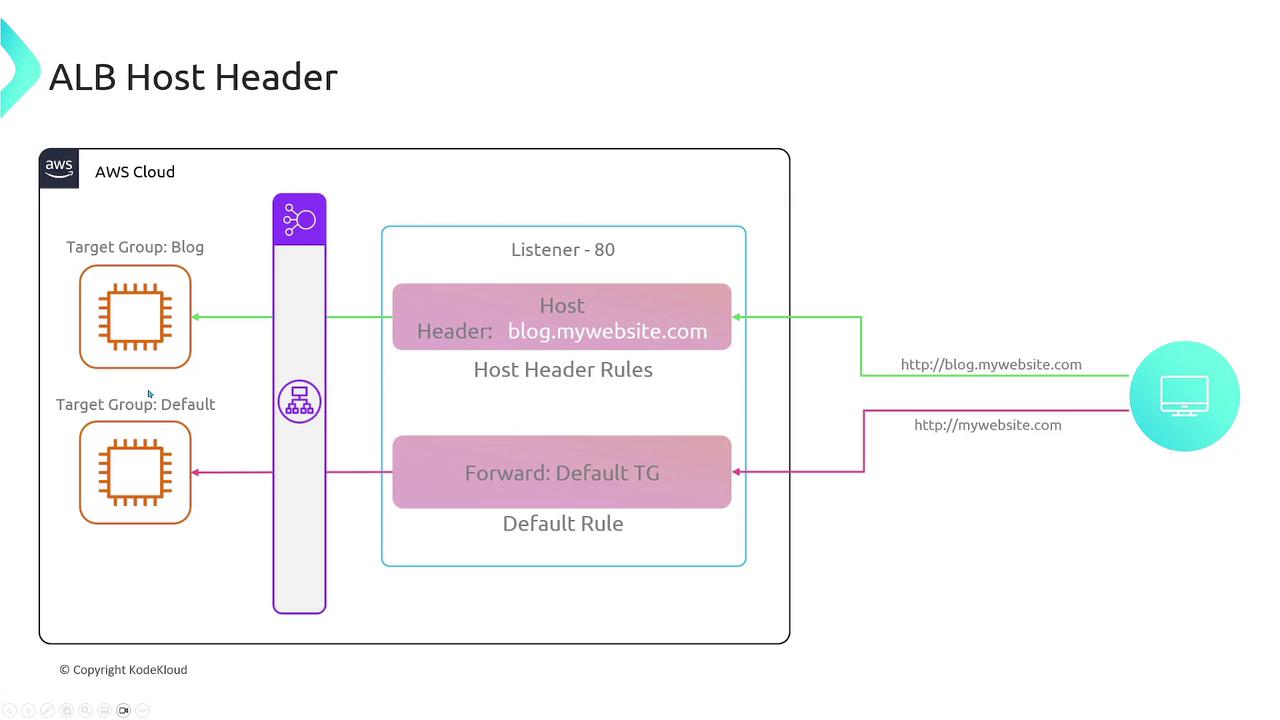
Path-Based Routing: Direct traffic based on URL paths (e.g., routing
/blogto a specific group).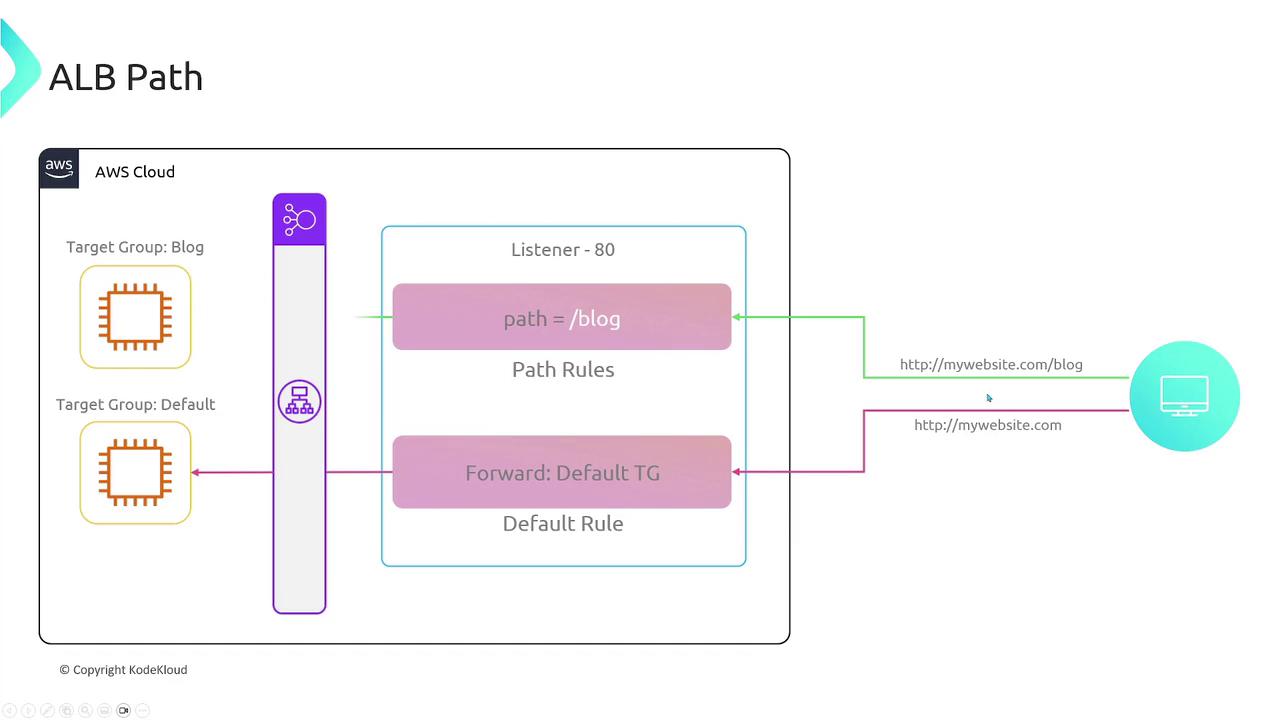
HTTP Method Matching: Distribute traffic based on HTTP methods (e.g., GET vs POST). For example, you might have separate target groups for POST requests.
An example using curl for a POST request:
curl -X POST -H "Content-Type: application/json" -d '{"key1":"value1"}' https://mywebsite.com/apiFor clarity, here is a similar command with escaped quotes:
curl -X POST -H "Content-Type: application/json" -d "{\"key1\":\"value1\"}" https://mywebsite.com/apiSource IP and Custom Header Matching: Create rules to match specific source IP addresses or HTTP headers (e.g.,
x-environment).For example, matching a header with curl:
curl -X POST -H "x-environment: staging" https://mywebsite.com/apiQuery String Matching: Route traffic based on query parameters, such as
?category=books.
Multiple routing rules can be combined to support complex microservices architectures. If none of the custom rules match, the load balancer reverts to the default rule.
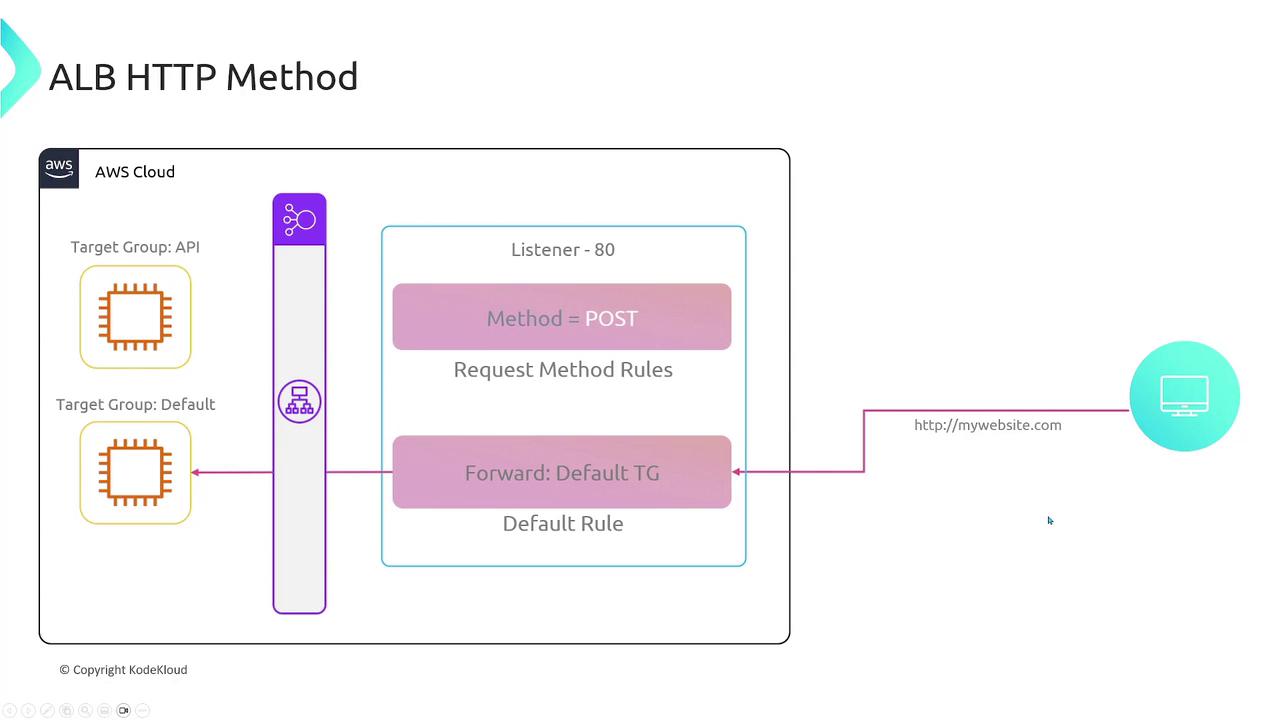
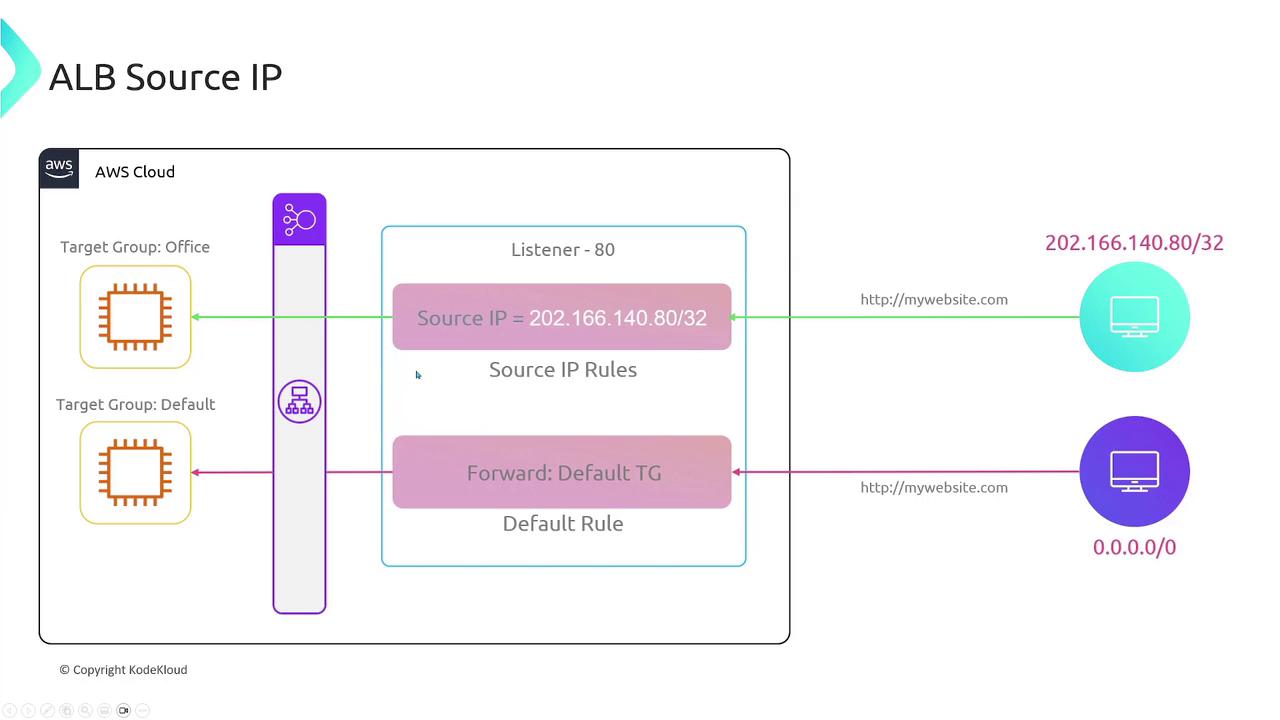
Integrations with AWS Services
Elastic Load Balancers seamlessly integrate with numerous AWS services, creating a robust and scalable architecture:
| AWS Service | Use Case | Example |
|---|---|---|
| Amazon EC2 | Distributing traffic to virtual servers | EC2 instances |
| Amazon ECS | Running containerized applications | Amazon ECS |
| AWS Lambda | Serverless computing for backend endpoints | AWS Lambda |
| AWS WAF | Adding web application firewall for security | Learn more about AWS WAF |
| Amazon Route 53 | Managing custom domains and routing policies | Learn more about Route 53 |
| Auto Scaling Groups | Automatically adjusting resource capacity | Auto Scaling Documentation |
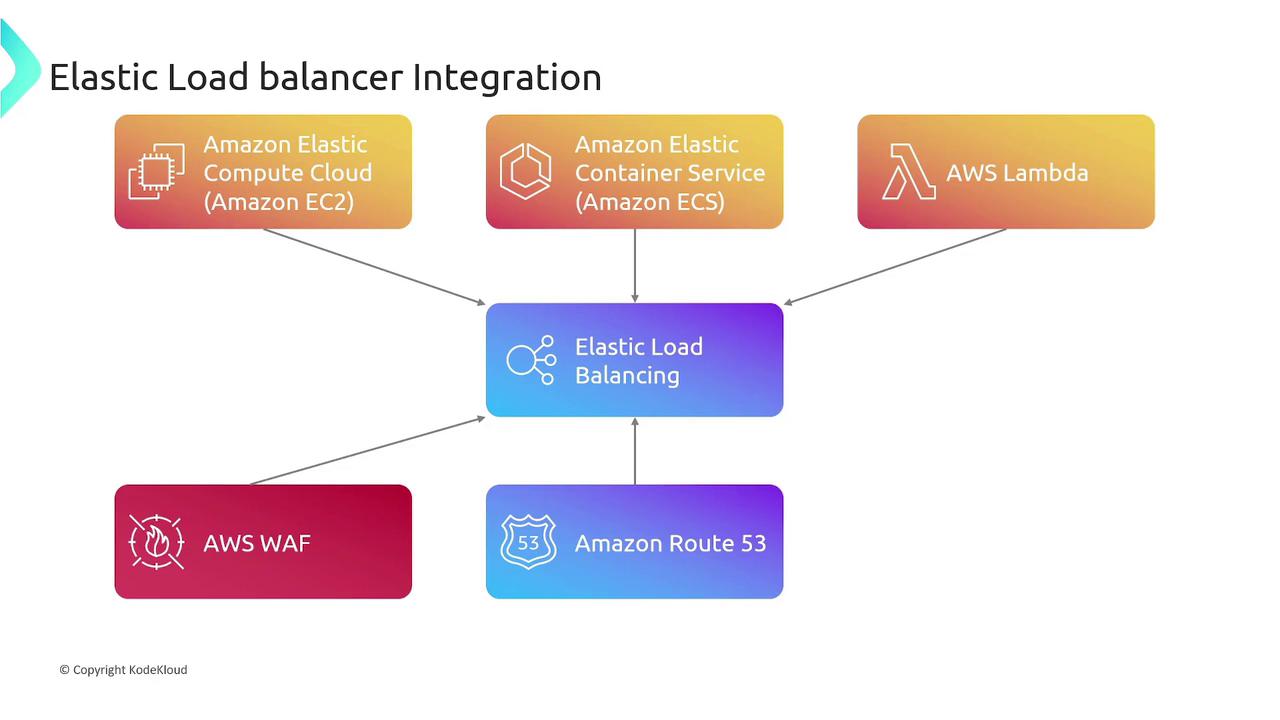
Integrating these services with Elastic Load Balancing not only provides scalability but also ensures that your applications remain resilient and highly available.
Best Practice
For optimal performance, always configure health checks on your target groups. This ensures that traffic is routed only to healthy endpoints.
This article provided an in-depth overview of AWS Elastic Load Balancers, discussing basic concepts, setup with listeners and target groups, distinctions between ALBs and NLBs, advanced routing techniques, and key integrations with other AWS services. By leveraging these capabilities, you can build a robust mechanism for managing traffic and ensuring high availability in your AWS cloud environment.
Watch Video
Watch video content
Practice Lab
Practice lab